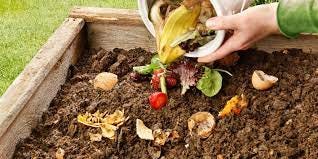Cass Marketos (CM) is a friend of WITI/writer and digital strategist based in Los Angeles. She’s built communities at Kickstarter, Google, and the Obama White House. Call her for your most interesting content strategy and community engagement projects. Her first compost edition is also worth re-reading here. She’s got a new newsletter on compost you should subscribe to. - Colin (CJN)
Cass here. I don’t know anybody who has good luck with compost tumblers. I get three to four calls a week about compost—people asking me to “fix” their piles—and almost all of them are from people who have compost tumblers. Why don’t they seem to work? Theoretically, they’re great. A seemingly tidy, aesthetically-pleasant compost solution—but all the things that make tumblers appealing to the amateur composter (no smells! no animals! no having to look at it!), are all the reasons, in my opinion, that they fail.
In order to make your compost good, you need to be able to get to know it. What do you see? What do you smell? Is the pile crumbly and dry? Is it slimy? These simple and observable features will help you make small adjustments, over time, to what you add and when you turn so that you can work your way toward an ideal pile. In my experience working with other people’s compost, tumblers often get… simply forgotten. They’re too easy, which becomes psychologically counterproductive. (“Oh, it just takes a few seconds to turn… so I can do it later…”) They also get overstuffed, leading to compaction, less airflow, and decreased decomposition rates.
Why is this interesting?
In general, any good compost pile needs the correct balance of nitrogen (a little) and carbon (a lot), plus air* and water. Nitrogen comes from things like food scraps, coffee grounds, grass clippings, and animal manure. Carbon comes from woody matter and brown yard waste, like dead leaves or woodchips. Air comes from turning the pile, or incorporating sturdy carbon materials that help break things up. Water comes from rain or, you know, a hose. Keeping these elements in productive ratio to each other is, simply, so much easier when you can just look at the pile directly.
Here are a few other things to look out for, and some suggestions about what you might do to correct them:
Compost that smells like ammonia. This means you have too much nitrogen in your pile. Add more high carbon inputs, like dead leaves or wood chips.
Compost that has formed big, damp clumps. Break it up! Add more nitrogen, to encourage decomposition, and make sure you’re turning the pile frequently.
Compost that smells bad, like rotting garbage. Add more carbon, baby. Add wood chips, dead leaves, sawdust, newspaper, or even soil. Anything to help break up your food scraps.
Compost that is very dry. Simply add water! If you live in a state with a lot of chlorine in your tap water, it can be helpful to let the water sit out for 24-36 hours, first, so that the chlorine evaporates. (Chlorine can have a suppressing effect on microbial communities, I hear.)
As a rule, I’m skeptical of any compost solutions that are “pretty” or even remotely expensive. You can build your own bin for, at max, $10 worth of supplies from Home Depot. Cinder blocks, wood slabs, chicken wire, and old trash cans all make excellent compost containers. So does digging a hole.
I often make this point to people who ask me about my compost: your greatest source of information about your pile is observation. I think you’ll be surprised at how joyful that becomes, and how good your finished compost is. Give it a try (and feel free to send me questions). (CM)
--
WITI x McKinsey:
An ongoing partnership where we highlight interesting McKinsey research, writing, and data.
Hybrid work and your DEI strategy. New research details what empowered employees love about hybrid work models and the risks to diversity, equity, and inclusion (DEI) if managers get the evolving flexible workplace wrong. A new article suggests three practices to prioritize to build a more inclusive culture.
–-
Thanks for reading,
Noah (NRB) & Colin (CJN) & Marketos (CM)
—
Why is this interesting? is a daily email from Noah Brier & Colin Nagy (and friends!) about interesting things. If you’ve enjoyed this edition, please consider forwarding it to a friend. If you’re reading it for the first time, consider subscribing (it’s free!).






I love this for its practicality, simplicity and presence of mind. This might sound like a stretch, but bear with me: reminds me of how dependent we have become on apps and A.I. to automatically calculate and accomplish tasks - which can be great and efficient and awesome, but can also prevent / detach us from being present in the world, from participating in it, from simple observation, from using our own senses.